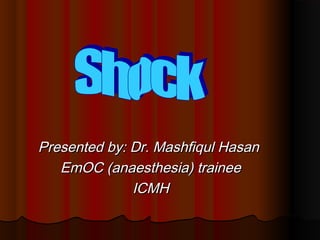Shock is a state of widespread tissue hypo perfusion caused by inadequate cardiac output or ineffective blood volume, leading to insufficient oxygen and nutrient supply to tissues. It can be classified into various types, including hypovolemic, cardiogenic, distributive, and obstructive shock, each with distinct causes and management strategies. The initial treatment aims at rapid re-expansion of the intravascular volume, use of oxygen inhalation, and targeted therapeutic interventions depending on the shock type.













































